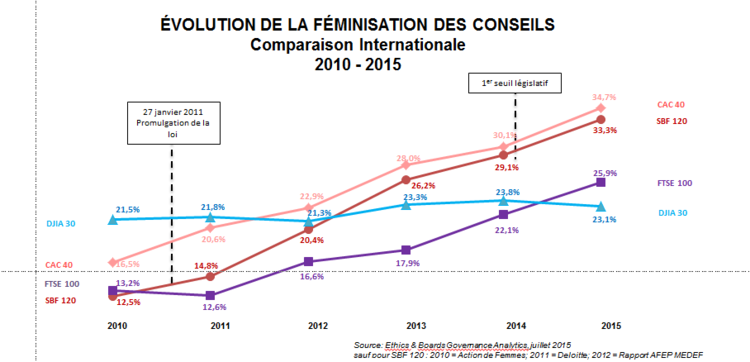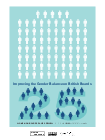mission et composition du conseil d’administration | Page 34
autres publications Gouvernance mission et composition du conseil d'administration
Féminisation des CA : comparaison internationale
Ivan Tchotourian 30 novembre 2015
L’Observatoire français Ethics & Boards vous propos de retrouver la présentation complète de l’intervention de Floriane de Saint Pierre, Présidente d’Ethics & Boards, à la soirée organisée par L’international au Féminin et L’Association des Femmes Canadiennes à Paris le 25 novembre 2015 : « Comment avoir #MoreWomenOnTop ? Opportunités à saisir, Exemples internationaux à suivre » (ici).
À la prochaine…
Ivan Tchotourian
autres publications Gouvernance mission et composition du conseil d'administration Normes d'encadrement normes de droit
CA et féminisation : 19,5 %
Ivan Tchotourian 23 novembre 2015
La féminisation des CA est un thème riche qui donne lieu à beaucoup de débats. Pour preuve cet article paru vendredi : « Les femmes occupent un siège sur cinq au Canada » (Le Devoir, 20 novembre 2015).
Les femmes occupent près d’un siège sur cinq au sein des conseils d’administration des plus grandes sociétés canadiennes, révèle un nouveau rapport.
Selon le rapport du Conseil canadien pour la diversité administrative dévoilé jeudi, des femmes occupent 19,5 % des sièges des conseils des sociétés classées sur le FP500 — une liste des 500 plus grandes sociétés canadiennes au chapitre des revenus — alors qu’elles n’en occupaient que 17,1 % l’an dernier. Il s’agit de la plus forte progression de la représentation des femmes au sein de ces conseils depuis 2001, a précisé le Conseil.
À la prochaine…
Ivan Tchotourian
mission et composition du conseil d'administration
Qu’attend-t-on d’un CA ? Réponse d’Andrew Bailey
Ivan Tchotourian 15 novembre 2015
Andrew Bailey, haut responable de la Prudential Regulation Authority britannique, s’est exprimé le 3 novembre 2015 devant la Banque d’Angleterre sur le thème suivant : « Governance and the role of Boards« . Je résume en quelques mots : rendre simple ce qui est complexe !
Morceau choisi :
The PRA has close contact with many Boards, so as supervisors what do we expect of Boards? Three things stand out for me:-
1. we expect Boards to exercise good judgment in overseeing the running of the firm and to do so on a forward-looking basis;
2. that judgement is improved by good constructive challenge from Non-Executives. A firm’s culture should promote discussion, debate and honest challenge. The alarm bells ring for us when we are told that the CEO or other Senior Executives are very sensitive to challenge;
3. so we as supervisors depend on Non-Executives, under the leadership of the Chair, to challenge the Executive in all aspects of the firm’s strategy, which includes the viability and sustainability of the business model and the establishment, maintenance and use of the risk appetite and management framework. We also of course rely on the Non-Executives to mentor and coach the Executives and balancing this with the essential ability to challenge is a vital component of an effective Board.
(…) So, let me put forward a proposition for Boards. It is the job of the Executive to be able to explain in simple and transparent terms these complex matters to Non-Executives. In doing so, you should understand the uncertainty around judgements, in what circumstances they could be wrong, and how there can reasonably be different ways to measure things like liquidity. Non-Executives should not be left to find the answers for themselves, and they should not feel that they have to do so out of a lack of sufficient confidence in what they are being told. In other words, they should not be pointed towards the haystack with warm wishes for the search ahead.
À la prochaine…
Ivan Tchotourian
autres publications mission et composition du conseil d'administration
Femmes, CA et Grande-Bretagne : « Women on boards: 5 year summary »
Ivan Tchotourian 2 novembre 2015
En 2011, Lord Davies avait publié des recommandations pour accroître la proportion des femmes au sein des CA des entreprises de l’indice FTSE100 avec un objectif d’au moins 25 % de femmes à l’horizon 2015. Quel est le bilan ?
Positif, pardi ! En effet, un rapport publié le 29 octobre 2015 (« Women on boards: 5 year summary (Davies Review) », Department for Business, Innovation & Skills) démontre que l’objectif a été atteint.
There are more women on FTSE 350 boards than ever before, with representation of women more than doubling since 2011 – now at 26.1% on FTSE 100 boards and 19.6% on FTSE 250 boards. We have also seen a dramatic reduction in the number of all-male boards. There were 152 in 2011. Today there are no all-male boards in the FTSE 100 and only 15 in the FTSE 250.
Parmi les 5 recommandations faites pour le futur, signalons :
- The national call for action and voluntary, business-led approach is continued for a further five year period, ensuring substantive and sustainable improvement in women’s representation on Boards of FTSE 350 companies into the future
- Increasing the voluntary target for women’s representation on Boards of FTSE 350 companies, to a minimum of 33% to be achieved in the next five years.
- All stakeholders to work together to ensure increasing numbers of women are appointed to the roles of Chair, Senior Independent Director and into Executive Director positions on Boards of FTSE 350 companies.
- All FTSE Listed companies now assess the gender balance on their Boards and take prompt action to address any shortfall
À la prochaine…
Ivan Tchotourian
engagement et activisme actionnarial Gouvernance mission et composition du conseil d'administration
CA, composition et Volkswagen
Ivan Tchotourian 14 octobre 2015
Le New York Times offre un magnifique article sur les liens entre le scandale Volkswagen et le rôle du conseil d’administration : « Problems at Volkswagen Start in the Boardroom » (24 septembre 2015).
Morceaux choisis :
One measure of Mr. Piëch’s influence: In 2012, shareholders elected his fourth wife, Ursula, a former kindergarten teacher who had been the Piëch family’s governess before her marriage to Ferdinand, to the company’s supervisory board.
Although many shareholders protested her lack of qualifications and independence, they have little or no influence. Porsche and Piëch family members own over half the voting shares and vote them as a bloc under a family agreement. Labor representatives hold three of the five seats on the powerful executive committee, and half the board seats are held by union officials and labor.
Of the remaining seats, two are appointed by the government of Lower Saxony, the northwestern German state that owns 20 percent of the voting shares. Two are representatives of Qatar Holding, Qatar’s sovereign wealth fund, which owns 17 percent of Volkswagen’s voting shares. Members of the Piëch and Porsche families hold three more seats, and a management representative holds another
À la prochaine…
Ivan Tchotourian
mission et composition du conseil d'administration
Retour sur le rôle de surveillant du CA
Ivan Tchotourian 8 octobre 2015
Bonjour à toutes et à tous, voici un intéressant billet tiré de les affaires sur le rôle de surveillant du CA et de l’importance de l’évaluer : « CA: le surveillant » (ici).
À la prochaine…
Ivan Tchotourian
autres publications mission et composition du conseil d'administration
ACVM : quelle conformité des entreprises avec le règlement 58-101 ?
Ivan Tchotourian 2 octobre 2015
Les Autorités canadiennes en valeurs mobilières (ACVM) ont publié le 28 septembre 2015 le résultat d’une enquête (Examen du personnel sur les femmes aux postes d’administrateurs et de membres de la haute direction – Conformité au Règlement 58‑101 sur l’information concernant les pratiques en matière de gouvernance (l’« Avis 58-307 ») : ici) réalisée auprès de 722 émetteurs inscrits à la Bourse de Toronto sur le respect des nouvelles obligations d’information au sujet de la représentation féminine au conseil d’administration et à la haute direction, à la suite de la mise en oeuvre depuis le 31 décembre 2014 des modifications au Règlement 58-101 sur l’information au sujet des pratiques en matière de gouvernance.
Qu’y apprend-t-on ?
- 51 % des entreprises n’auraient même pas une seule femme à leur CA
- 49 % comptent au moins une femme au CA
- 40 % n’auraient même pas une seule femme au sein de leur haute direction.
- 60 % comptent au moins une femme à la haute direction
- 15 % ont ajouté une femme ou plus au conseil au cours de l’exercice.
L’examen a également révélé que la taille et le secteur d’activité des émetteurs étaient les indicateurs les plus significatifs de l’adoption ou non par ceux-ci de mesures visant à accroître la représentation féminine au conseil ou à la haute direction.
Par contre, sur la période du 31 décembre 2014 au 31 mars 2015, environ 14 % des émetteurs de l’échantillon avaient adopté une politique écrite pour identifier et nominer des administratrices. Parmi eux, seulement 47 % avaient établi des cibles spécifiques en matière de femmes administratrices.
À la prochaine…
Ivan Tchotourian


